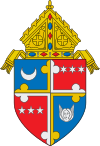
Georgetown University is a private Jesuit research university in Georgetown neighborhood of Washington, D.C., United States. Founded by Bishop John Carroll in 1789 as Georgetown College, it is the oldest Catholic institution of higher education in the United States and the nation's first federally chartered university.

Georgetown is a historic neighborhood and commercial district in Northwest Washington, D.C., situated along the Potomac River. Founded in 1751 as part of the colonial-era Province of Maryland, Georgetown predated the establishment of Washington, D.C. by 40 years. Georgetown was an independent municipality until 1871 when the United States Congress created a new consolidated government for the entire District of Columbia. A separate act, passed in 1895, repealed Georgetown's remaining local ordinances and renamed Georgetown's streets to conform with those in Washington, D.C..
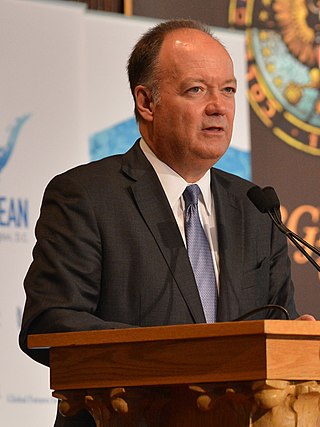
John Joseph DeGioia is an American academic administrator and philosopher who has been the president of Georgetown University since 2001. He is the first lay president of the school and is currently its longest-serving president. Upon his appointment, he also became the first lay president of any Jesuit university in the United States. Having spent his entire career at Georgetown, where he received his undergraduate and graduate degrees, DeGioia was the dean of student affairs and held various vice presidential positions before becoming president.
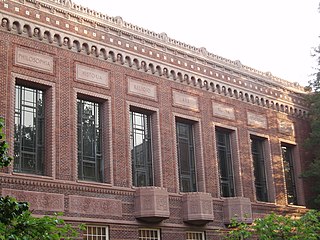
Knight Library is the main facility of the University of Oregon's (UO) library system. It is located on the university's campus in Eugene, Oregon, United States. The library design is emblematic of the architecture of the university's older buildings, and it serves as a hub of student activity. As of 2008 it has a collection of more than 3 million volumes. The library also holds collections of primary sources such as photographs and manuscripts on various topics at the Special Collections & University Archives. It is also a depository for the Federal Depository Library Program. The library was previously known as the Main Library and it was renamed the Knight Library in 1988, in honor of the family of Phil Knight.

The Georgetown Hoyas are the collegiate athletics teams that officially represent Georgetown University, located in Washington, D.C. Georgetown's athletics department fields 24 men's and women's varsity level teams and competes at the National Collegiate Athletic Association (NCAA) Division I level as a member of the Big East Conference, with the exception of the Division I FCS Patriot League in football and women's heavyweight rowing. The University also fields 5 non-NCAA varsity teams in men's heavyweight and lightweight rowing, women's lightweight rowing, women's squash, and sailing. In late 2012, Georgetown and six other Catholic, non-FBS schools announced that they were departing the Big East for a new conference. The rowing and sailing teams also participate in east coast conferences. The men's basketball team is the school's most famous and most successful program, but Hoyas have achieved success in a wide range of sports.

Leo Jeremiah O'Donovan III is an American Catholic priest, Jesuit, and theologian who served as the president of Georgetown University from 1989 to 2001. Born in New York City, he graduated from Georgetown, and while studying in France, decided to enter the Society of Jesus. He went on to receive advanced degrees from Fordham University and Woodstock College, and received his doctorate in theology from the University of Münster, where he studied under Karl Rahner. Upon returning to the United States, he became a professor at Woodstock College and the Weston Jesuit School of Theology, before becoming the president of the Catholic Theological Society of America and a senior administrator in the Jesuit Maryland Province.

Healy Hall is a National Historic Landmark and the flagship building of the main campus of Georgetown University in Washington, D.C., United States. Constructed between 1877 and 1879, the hall was designed by Paul J. Pelz and John L. Smithmeyer, both of whom also designed the Thomas Jefferson Building of the Library of Congress. The structure is named after Patrick Francis Healy, who was the President of Georgetown University at the time.
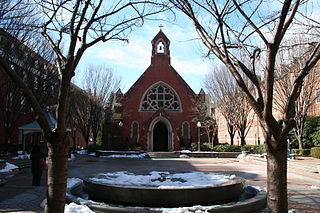
The history of Georgetown University spans nearly 400 years, from the early European settlement of America to the present day. Georgetown University has grown with both its city, Washington, D.C., and the United States, each of which date their founding to the period from 1788 to 1790. Georgetown's origins are in the establishment of the Maryland colony in the seventeenth century. Bishop John Carroll established the school at its present location by the Potomac River after the American Revolution allowed for free religious practice.
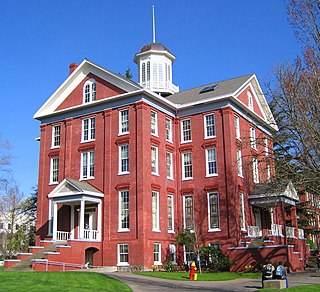
Waller Hall is a building on the campus of Willamette University in Salem, Oregon, in the United States. Opened in 1867 as University Hall, it is the oldest higher-education building west of the Mississippi River still in use, currently housing the university's administrative offices.

The Campuses of Georgetown University, the Law School Campus, the Main Campus, and the Medical Campus, are located within Washington, D.C. Georgetown's Main and Medical Campuses are located in Georgetown, Washington, D.C. between Canal Road, Prospect Street, and Reservoir Road. The Law Campus is located in downtown DC on New Jersey Avenue, near Union Station. Other parts of Georgetown are located in the D.C. Area, including the Center for Continuing and Professional Education at Clarendon in Arlington, Virginia. Georgetown also has an overseas campus in Education City, Qatar, and villas in Alanya, Turkey and Fiesole, Italy.

Housing at Georgetown University consists of 13 residence halls at the main campus and a law center campus. Housing on Georgetown's main campus is divided between "halls," usually more traditional dormitories, and "villages", usually less traditional apartment complexes. In addition, Georgetown operates many townhouses in the Georgetown neighborhood, usually for second, third, and fourth-year students.

Duncan Gregory Stroik, usually credited as Duncan G. Stroik, is an American architect, a professor of architecture at the University of Notre Dame School of Architecture, and founding editor of the Sacred Architecture Journal. His work continues the tradition of classical and Palladian architecture, also known as New Classical Architecture.

Bishop John Carroll is a statue by the sculptor Jerome Connor commemorating Archbishop John Carroll, the founder of Georgetown University and the first Catholic bishop in the United States. Located in front of Healy Hall, on university's campus in the Georgetown neighborhood of Washington, D.C., the statue consists of a bronze sculpture of Carroll on top of a granite pedestal.
Philip L. Boroughs, S.J., is an American Jesuit, academic and university administrator. Boroughs was unanimously selected as the incoming 32nd President of the College of the Holy Cross on May 6, 2011. He took office on January 9, 2012, when Rev. Michael C. McFarland, S.J., who had served as President of Holy Cross since 2000, stepped down. He served in the role until the end of the 2020-21 academic year, when he was succeeded by Vincent Rougeau.
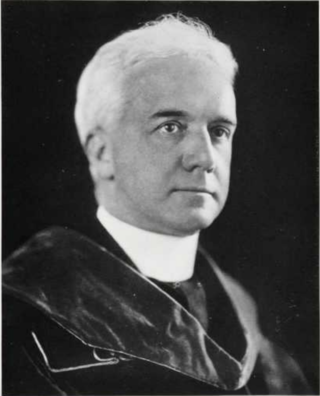
William Coleman Nevils was an American Catholic priest and Jesuit educator who became the head of numerous Jesuit institutions throughout the northeastern United States, including Georgetown University and the University of Scranton. Born in Philadelphia, he was educated at Saint Joseph's College, before entering the Society of Jesus. While studying for the priesthood, he taught at Boston College and the Loyola School. After receiving his doctorate from Woodstock College, he held professorships at St. Andrew-on-Hudson and the College of the Holy Cross, before transferring to Georgetown University, where he became the dean of Georgetown College, the academic vice president, and the regent of the School of Foreign Service. He then left Georgetown to become the dean of the Shadowbrook Jesuit House of Studies.
On June 19, 1838, the Maryland Province of the Society of Jesus agreed to sell 272 slaves to two Louisiana planters, Henry Johnson and Jesse Batey, for $115,000. This sale was the culmination of a contentious and long-running debate among the Maryland Jesuits over whether to keep, sell, or free their slaves, and whether to focus on their rural estates or on their growing urban missions, including their schools.
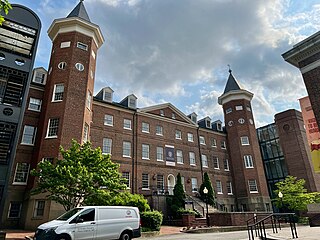
The Old North Building, or simply Old North, is the oldest extant academic building on the campus of Georgetown University in Washington, D.C., and was the second major building built on the campus. To the east, the building is joined to Healy Hall and to the west, it is joined to New North, while the southern façade of the building encloses Dahlgren Chapel. Built in the Georgian style, Old North was one of the grandest buildings in Washington at the time of its completion in 1795. It served as the flagship of the university until the construction of Healy Hall. Old North currently houses the McCourt School of Public Policy.

West Campus is part of Duke University's campus in Durham, North Carolina. West Campus, along with East Campus, make up most of Duke's main campus. The campus follows the Collegiate Gothic architecture style, inspired by the mid-18th century Gothic Revival style, making it distinct from East Campus. This was in a similar set-up as Cornell University's West Campus built a decade prior.
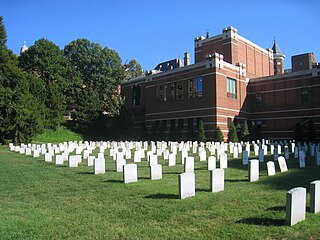
The Jesuit Community Cemetery on the campus of Georgetown University in Washington, D.C., is the final resting place for Jesuits who were affiliated with the university. It was first established in 1808 and was moved to its present location in 1854.

The Georgetown Car Barn, historically known as the Capital Traction Company Union Station, is a building in the Georgetown neighborhood of Washington, D.C., in the United States. Designed by the architect Waddy Butler Wood, it was built between 1895 and 1897 by the Capital Traction Company as a union terminal for several Washington and Virginia streetcar lines. The adjacent Exorcist steps, later named after their appearance in William Friedkin's 1973 horror film The Exorcist, were built during the initial construction to connect M Street with Prospect Street.































